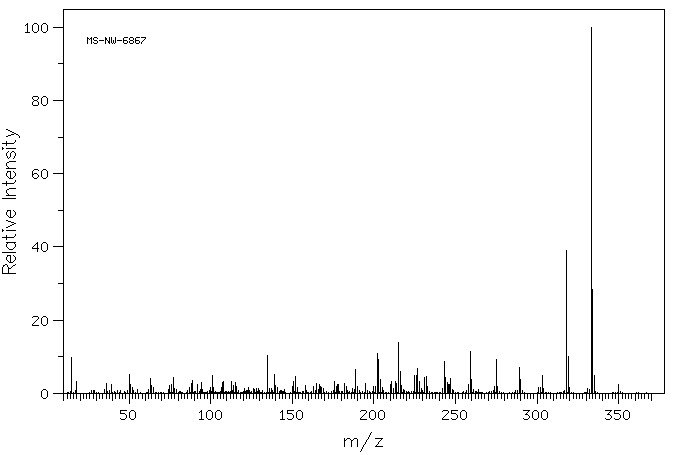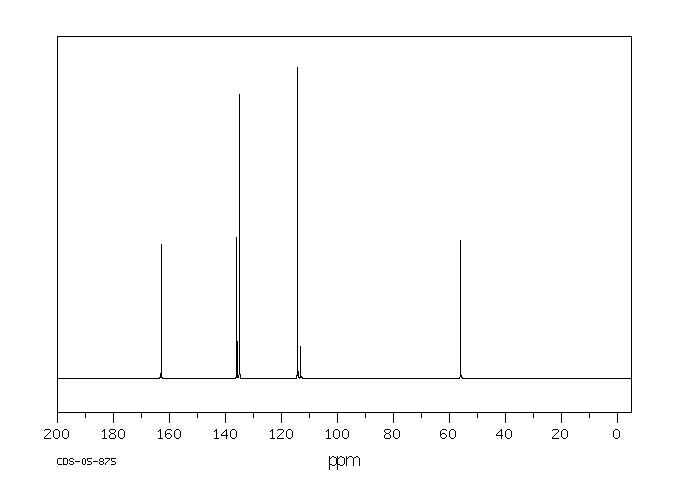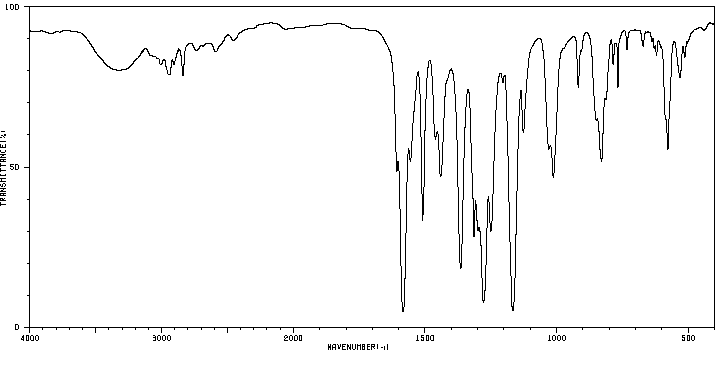4,4’,4’-三甲氧基苯甲基氯 | 49757-42-8
中文名称
4,4’,4’-三甲氧基苯甲基氯
中文别名
4,4',4'-三甲氧基苯甲基氯;4,4',4'-三甲氧基三苯甲基氯;4,4`,4`-三甲氧基苯甲基氯;4,4',4''-三甲氧基三苯甲基氯
英文名称
4,4',4''-trimethoxytrityl chloride
英文别名
4,4',4"-trimethoxytrityl chloride;4,4',4''-(chloromethanetriyl)tris(methoxybenzene);1-[chloro-bis(4-methoxyphenyl)methyl]-4-methoxybenzene
CAS
49757-42-8
化学式
C22H21ClO3
mdl
MFCD00008408
分子量
368.86
InChiKey
OBFCMKPFILBCSQ-UHFFFAOYSA-N
BEILSTEIN
——
EINECS
——
-
物化性质
-
计算性质
-
ADMET
-
安全信息
-
SDS
-
制备方法与用途
-
上下游信息
-
文献信息
-
表征谱图
-
同类化合物
-
相关功能分类
-
相关结构分类
物化性质
-
熔点:146-148 °C(lit.)
-
沸点:497.8±45.0 °C(Predicted)
-
密度:1.166±0.06 g/cm3(Predicted)
-
稳定性/保质期:
如果按照规格使用和储存,则不会分解,未有已知危险反应。
计算性质
-
辛醇/水分配系数(LogP):5.4
-
重原子数:26
-
可旋转键数:6
-
环数:3.0
-
sp3杂化的碳原子比例:0.181
-
拓扑面积:27.7
-
氢给体数:0
-
氢受体数:3
安全信息
-
危险品标志:Xi
-
安全说明:S26,S36
-
危险类别码:R36/37/38
-
海关编码:2909309090
-
WGK Germany:3
-
危险标志:GHS07
-
危险性描述:H315,H319,H335
-
危险性防范说明:P261,P305 + P351 + P338
-
储存条件:密封,在0-5°C下保存
SDS
Section 1. IDENTIFICATION OF THE SUBSTANCE/MIXTURE
Product identifiers
: 4,4′,4′′-Trimethoxytrityl chloride
Product name
CAS-No. : 49757-42-8
Relevant identified uses of the substance or mixture and uses advised against
Identified uses : Laboratory chemicals, Manufacture of substances
Section 2. HAZARDS IDENTIFICATION
Classification of the substance or mixture
Classification according to Regulation (EC) No 1272/2008 [EU-GHS/CLP]
Skin irritation (Category 2)
Eye irritation (Category 2)
Specific target organ toxicity - single exposure (Category 3)
Classification according to EU Directives 67/548/EEC or 1999/45/EC
Irritating to eyes, respiratory system and skin.
Label elements
Labelling according Regulation (EC) No 1272/2008 [CLP]
Pictogram
Signal word Warning
Hazard statement(s)
H315 Causes skin irritation.
H319 Causes serious eye irritation.
H335 May cause respiratory irritation.
Precautionary statement(s)
P261 Avoid breathing dust/ fume/ gas/ mist/ vapours/ spray.
P305 + P351 + P338 IF IN EYES: Rinse cautiously with water for several minutes. Remove
contact lenses, if present and easy to do. Continue rinsing.
Supplemental Hazard none
Statements
According to European Directive 67/548/EEC as amended.
Hazard symbol(s)
R-phrase(s)
R36/37/38 Irritating to eyes, respiratory system and skin.
S-phrase(s)
S26 In case of contact with eyes, rinse immediately with plenty of water and
seek medical advice.
S37/39 Wear suitable gloves and eye/face protection.
Other hazards - none
Section 3. COMPOSITION/INFORMATION ON INGREDIENTS
Substances
Formula : C22H21ClO3
Molecular Weight : 368,85 g/mol
Component Concentration
4,4',4''-Trimethoxytrityl chloride
CAS-No. 49757-42-8 -
EC-No. 256-474-6
Section 4. FIRST AID MEASURES
Description of first aid measures
General advice
Consult a physician. Show this safety data sheet to the doctor in attendance.
If inhaled
If breathed in, move person into fresh air. If not breathing, give artificial respiration. Consult a physician.
In case of skin contact
Wash off with soap and plenty of water. Consult a physician.
In case of eye contact
Rinse thoroughly with plenty of water for at least 15 minutes and consult a physician.
If swallowed
Never give anything by mouth to an unconscious person. Rinse mouth with water. Consult a physician.
Most important symptoms and effects, both acute and delayed
To the best of our knowledge, the chemical, physical, and toxicological properties have not been
thoroughly investigated.
Indication of any immediate medical attention and special treatment needed
no data available
Section 5. FIREFIGHTING MEASURES
Extinguishing media
Suitable extinguishing media
Use water spray, alcohol-resistant foam, dry chemical or carbon dioxide.
Special hazards arising from the substance or mixture
Hydrogen chloride gas
Carbon oxides, Hydrogen chloride gas
Advice for firefighters
Wear self contained breathing apparatus for fire fighting if necessary.
Further information
no data available
Section 6. ACCIDENTAL RELEASE MEASURES
Personal precautions, protective equipment and emergency procedures
Use personal protective equipment. Avoid dust formation. Avoid breathing vapors, mist or gas. Ensure
adequate ventilation. Evacuate personnel to safe areas. Avoid breathing dust.
Environmental precautions
Do not let product enter drains.
Methods and materials for containment and cleaning up
Pick up and arrange disposal without creating dust. Sweep up and shovel. Keep in suitable, closed
containers for disposal.
Reference to other sections
For disposal see section 13.
Section 7. HANDLING AND STORAGE
Precautions for safe handling
Avoid contact with skin and eyes. Avoid formation of dust and aerosols.
Provide appropriate exhaust ventilation at places where dust is formed.Normal measures for preventive fire
protection.
Conditions for safe storage, including any incompatibilities
Store in cool place. Keep container tightly closed in a dry and well-ventilated place.
Specific end uses
no data available
Section 8. EXPOSURE CONTROLS/PERSONAL PROTECTION
Control parameters
Components with workplace control parameters
Exposure controls
Appropriate engineering controls
Handle in accordance with good industrial hygiene and safety practice. Wash hands before breaks and
at the end of workday.
Personal protective equipment
Eye/face protection
Safety glasses with side-shields conforming to EN166 Use equipment for eye protection tested
and approved under appropriate government standards such as NIOSH (US) or EN 166(EU).
Skin protection
Handle with gloves. Gloves must be inspected prior to use. Use proper glove removal technique
(without touching glove's outer surface) to avoid skin contact with this product. Dispose of
contaminated gloves after use in accordance with applicable laws and good laboratory practices.
Wash and dry hands.
The selected protective gloves have to satisfy the specifications of EU Directive 89/686/EEC and
the standard EN 374 derived from it.
Body Protection
impervious clothing, The type of protective equipment must be selected according to the
concentration and amount of the dangerous substance at the specific workplace.
Respiratory protection
For nuisance exposures use type P95 (US) or type P1 (EU EN 143) particle respirator.For higher
level protection use type OV/AG/P99 (US) or type ABEK-P2 (EU EN 143) respirator cartridges.
Use respirators and components tested and approved under appropriate government standards
such as NIOSH (US) or CEN (EU).
Section 9. PHYSICAL AND CHEMICAL PROPERTIES
Information on basic physical and chemical properties
a) Appearance Form: powder
Colour: orange
b) Odour no data available
c) Odour Threshold no data available
d) pH no data available
e) Melting point/freezing Melting point/range: 146 - 148 °C - lit.
point
f) Initial boiling point and no data available
boiling range
g) Flash point no data available
h) Evaporation rate no data available
i) Flammability (solid, gas) no data available
j) Upper/lower no data available
flammability or
explosive limits
k) Vapour pressure no data available
l) Vapour density no data available
m) Relative density no data available
n) Water solubility no data available
o) Partition coefficient: n- no data available
octanol/water
p) Autoignition no data available
temperature
q) Decomposition no data available
temperature
r) Viscosity no data available
s) Explosive properties no data available
t) Oxidizing properties no data available
Other safety information
no data available
Section 10. STABILITY AND REACTIVITY
Reactivity
no data available
Chemical stability
no data available
Possibility of hazardous reactions
no data available
Conditions to avoid
no data available
Incompatible materials
Strong bases
Hazardous decomposition products
Other decomposition products - no data available
Section 11. TOXICOLOGICAL INFORMATION
Information on toxicological effects
Acute toxicity
no data available
Skin corrosion/irritation
no data available
Serious eye damage/eye irritation
no data available
Respiratory or skin sensitization
no data available
Germ cell mutagenicity
no data available
Carcinogenicity
IARC: No component of this product present at levels greater than or equal to 0.1% is identified as
probable, possible or confirmed human carcinogen by IARC.
Reproductive toxicity
no data available
Specific target organ toxicity - single exposure
Inhalation - May cause respiratory irritation.
Specific target organ toxicity - repeated exposure
no data available
Aspiration hazard
no data available
Potential health effects
Inhalation May be harmful if inhaled. Causes respiratory tract irritation.
Ingestion May be harmful if swallowed.
Skin May be harmful if absorbed through skin. Causes skin irritation.
Eyes Causes serious eye irritation.
Signs and Symptoms of Exposure
To the best of our knowledge, the chemical, physical, and toxicological properties have not been
thoroughly investigated.
Additional Information
RTECS: Not available
Section 12. ECOLOGICAL INFORMATION
Toxicity
no data available
Persistence and degradability
no data available
Bioaccumulative potential
no data available
Mobility in soil
no data available
Results of PBT and vPvB assessment
no data available
Other adverse effects
no data available
Section 13. DISPOSAL CONSIDERATIONS
Waste treatment methods
Product
Offer surplus and non-recyclable solutions to a licensed disposal company. Contact a licensed
professional waste disposal service to dispose of this material. Dissolve or mix the material with a
combustible solvent and burn in a chemical incinerator equipped with an afterburner and scrubber.
Contaminated packaging
Dispose of as unused product.
Section 14. TRANSPORT INFORMATION
UN number
ADR/RID: - IMDG: - IATA: -
UN proper shipping name
ADR/RID: Not dangerous goods
IMDG: Not dangerous goods
IATA: Not dangerous goods
Transport hazard class(es)
ADR/RID: - IMDG: - IATA: -
Packaging group
ADR/RID: - IMDG: - IATA: -
Environmental hazards
ADR/RID: no IMDG Marine pollutant: no IATA: no
Special precautions for user
no data available
SECTION 15 - REGULATORY INFORMATION
N/A
SECTION 16 - ADDITIONAL INFORMATION
N/A
上下游信息
-
上游原料
中文名称 英文名称 CAS号 化学式 分子量 4,4’,4’-三甲氧基苯基甲醇 tris(4-methoxyphenyl)methanol 3010-81-9 C22H22O4 350.414 -
下游产品
中文名称 英文名称 CAS号 化学式 分子量 1-[双(4-甲氧基苯基)甲基]-4-甲氧基苯 tris(4-methoxyphenyl)methane 7511-68-4 C22H22O3 334.415 —— tetrakis(4-methoxyphenyl)methane —— C29H28O4 440.539 三(4-甲氧基苯基)甲胺 4,4',4''-trimethoxytritylamine 154776-46-2 C22H23NO3 349.43 4,4’,4’-三甲氧基苯基甲醇 tris(4-methoxyphenyl)methanol 3010-81-9 C22H22O4 350.414 —— 4,4',4''-(prop-2-yne-1,1,1-triyl)tris(methoxybenzene) 816423-13-9 C24H22O3 358.437 —— tris(4-methoxyphenyl)acetonitrile 37964-78-6 C23H21NO3 359.425 —— tris-(4-methoxyphenyl)methyl methyl ether 85013-34-9 C23H24O4 364.441
反应信息
-
作为反应物:描述:4,4’,4’-三甲氧基苯甲基氯 以 甲醇 为溶剂, 反应 60.0h, 以94%的产率得到1-[双(4-甲氧基苯基)甲基]-4-甲氧基苯参考文献:名称:Huszthy, Peter; Lempert, Karoly; Simig, Gyula, Journal of the Chemical Society. Perkin transactions II, 1982, p. 1671 - 1674摘要:DOI:
-
作为产物:描述:参考文献:名称:Spectral Detection of a Transient Ion Pair Intermediate in the Reaction of a Triarylmethyl Chloride with Pyrrole in Benzene Solution1,2摘要:DOI:10.1021/ja01622a080
-
作为试剂:描述:potassium ((4-methoxyphenyl)ethynyl)trifluoroborate 、 四氢呋喃 在 gallium(III) trichloride 、 4,4’,4’-三甲氧基苯甲基氯 作用下, 以 二氯甲烷 为溶剂, 反应 1.0h, 以55%的产率得到2-((4-methoxyphenyl)ethynyl)tetrahydrofuran参考文献:名称:实用且高度选择性的C ?H结构多样的醚的功能化摘要:在环境温度下,已开发出由三苯甲基离子介导的具有多种亲核试剂的醚的CH功能化。该反应显示出高的化学选择性和良好的官能团耐受性。该协议还对非对称醚表现出出色的区域选择性和非对映选择性,因此立体选择性地生成高度官能化的二取代的2,5-反式四氢呋喃(THF),2,6-反式四氢吡喃(THP),2,6-反式二氢吡喃(DHP),和1,3-反式异色团,并突出了该协议在复杂分子合成中的能力。DOI:10.1002/anie.201407083
文献信息
-
SOLID SUPPORTS AND PHOSPHORAMIDITE BUILDING BLOCKS FOR OLIGONUCLEOTIDE CONJUGATES申请人:AM Chemicals LLC公开号:US20180016232A1公开(公告)日:2018-01-18Novel non-nucleoside solid supports and phosphoramidite building blocks for preparation of synthetic oligonucleotides containing at least one non-nucleosidic moiety conjugated to a ligand of practical interest and synthetic processes for making the same are disclosed. Furthermore, oligomeric compounds are prepared using said solid supports and phosphoramidite building blocks, preferably followed by removal of protecting groups to provide oligonucleotides conjugated to ligands of interest.
-
Labeled oligonucleotides, methods for making same, and compounds useful therefor申请人:——公开号:US20030208061A1公开(公告)日:2003-11-06Selectively functionalized oligonucleotides, methods for making same, and compounds useful therefor are disclosed. The oligonucleotides can be selectively functionalized with a first conjugate group at the 3′-terminial position and optionally functionalized with a second conjugate group at the 5′-terminal position and/or one or more internucleotides. Alternatively, the oligonucleotides can be selectively functionalized with a first conjugate group at the 5′-terminal position and optionally functionalized with a second conjugate group at one or more internucleotides. In yet another embodiment, the oligonucleotides can be functionalized with a first conjugate group at one or more internucleotides and with a second conjugate group at one or more different internucleotides.选择性功能化寡核苷酸,制备方法以及用于此目的的化合物已被披露。这些寡核苷酸可以在3'-末端位置选择性地与第一共轭基团功能化,并可选择性地在5'-末端位置和/或一个或多个核苷酸之间与第二共轭基团功能化。另外,这些寡核苷酸可以在5'-末端位置选择性地与第一共轭基团功能化,并可选择性地在一个或多个核苷酸之间与第二共轭基团功能化。在另一实施方式中,这些寡核苷酸可以在一个或多个核苷酸之间与第一共轭基团功能化,并在一个或多个不同的核苷酸之间与第二共轭基团功能化。
-
Synthesis and biological evaluation of novel N-substituted nipecotic acid derivatives with an alkyne spacer as GABA uptake inhibitors作者:Krisztián Tóth、Georg Höfner、Klaus T. WannerDOI:10.1016/j.bmc.2018.05.049日期:2018.7In this study, we present the synthesis and structure–activity relationships (SAR) of novel N-substituted nipecotic acid derivatives closely related to (S)-SNAP-5114 (2) in the pursuit of finding new and potent mGAT4 selective inhibitors. By the use of iminium ion chemistry, a series of new N-substituted nipecotic acid derivatives containing a variety of heterocycles, and an alkyne spacer were synthesized
-
Exploring the effects of cooperative interactions on affinity using a pinwheel sensor system作者:Paul D. Jones、Timothy E. GlassDOI:10.1016/j.tet.2004.08.048日期:2004.11A series of three pinwheel sensors were constructed with 1, 2, and 3 binding sites. Binding of Zn+2 and Cd+2 was monitored by fluorescence over a range of temperatures. The data demonstrate that cooperative interactions generally increase the effective affinity of the sensor. This effect is more pronounced in systems which have lower inherent affinity for the analyte.构造了三个带有1个,2个和3个结合位点的风车传感器系列。Zn +2和Cd +2的结合通过在一定温度范围内的荧光进行监测。数据表明,协同相互作用通常会增加传感器的有效亲和力。在对分析物的固有亲和力较低的系统中,这种效应更为明显。
-
MELANIN PRODUCTION INHIBITOR申请人:Yokoyama Kouji公开号:US20110243865A1公开(公告)日:2011-10-06Disclosed is a melanin production inhibitor which has an excellent inhibitory activity on the production of melanin and is highly safe. The melanin production inhibitor comprises a compound represented by general formula (1) (excluding clotrimazole), and/or a pharmacologically acceptable salt thereof. In the formula, A1, A2 and A3 are independently selected from a hydrogen atom, an aryl group which may have a substituent, and an aromatic heterocyclic group which may have a substituent, wherein at least one of A1, A2 and A3 is selected from the aryl group and the aromatic heterocyclic group, the total number of carbon atoms contained in A1, A2 and A3 is 6 to 50 and, when at least two of A1, A2 and A3 represent the aryl groups or the aromatic heterocyclic groups, the adjacent two aryl or aromatic heterocyclic groups may be bound to each other via an alkyl chain or an alkenyl chain to form a ring; m represents an integer of 0 to 2; X represents a hetero atom, a hydrogen atom, or a carbon atom; R1 and R2 are independently selected from a hydrogen atom and an oxo group, wherein when one of R1 and R2 is an oxo group, the other is not present; and R3 is selected from a hydrogen atom, and a C 1-8 hydrocarbon group in which one or some of hydrogen atoms or carbon atoms may be substituted by a hetero atom or hetero atoms, wherein the number of R3's present in the compound corresponds to the number of X's and, when two or more R3's are present, the R3's are independently present and the adjacent two R3's may be bound to each other to form, together with X, a ring, and the terminal of R3 may be bound to a carbon atom to which A1, A2 and A3 are bound, thereby forming a ring.披露了一种黑色素生产抑制剂,它对黑色素的生产具有出色的抑制活性且高度安全。该黑色素生产抑制剂包括由通用公式(1)表示的化合物(不包括克霉唑)和/或其药理上可接受的盐。在公式中,A1、A2和A3独立地选自氢原子、可能带有取代基的芳基团和可能带有取代基的芳香杂环团,其中至少A1、A2和A3之一选自芳基团和芳香杂环团,A1、A2和A3中包含的碳原子总数为6至50,并且当至少两个A1、A2和A3表示芳基团或芳香杂环团时,相邻的两个芳基或芳香杂环团可以通过烷基链或烯基链相互连接形成环;m代表0至2的整数;X代表异原子、氢原子或碳原子;R1和R2独立地选自氢原子和氧代基,其中当R1和R2之一是氧代基时,另一个不出现;R3选自氢原子和C 1-8 碳氢化合物组,其中一些或所有的氢原子或碳原子可能被异原子或异原子取代,其中化合物中存在的R3的数量对应于X的数量,并且当存在两个或更多R3时,R3独立地存在,并且相邻的两个R3可以相互连接以与X一起形成环,并且R3的末端可以与A1、A2和A3连接的碳原子结合,从而形成环。
表征谱图
-
氢谱1HNMR
-
质谱MS
-
碳谱13CNMR
-
红外IR
-
拉曼Raman
-
峰位数据
-
峰位匹配
-
表征信息
同类化合物
(3-三苯基甲氨基甲基)吡啶
非马沙坦杂质1
隐色甲紫-d6
隐色孔雀绿-d6
隐色孔雀绿
隐色乙基结晶紫
降钙素杂质10
重氮四苯基乙烷
酸性黄117
酸性蓝119
酚酞啉
酚酞二硫酸钾水合物
萘,1-甲氧基-3-甲基
苯酚,4-(1,1-二苯基丙基)-
苯甲醇,4-溴-a-(4-溴苯基)-a-苯基-
苯甲醇,2-氨基-5-氯-a-乙烯基-a-苯基-
苯甲酸,4-(羟基二苯甲基)-,甲基酯
苯甲酸,3-[[2-[[(1,1-二甲基乙氧基)羰基]氨基]-3-[(三苯代甲基)硫代]丙基]氨基]-,(R)-
苯甲基N-[(2(三苯代甲基四唑-5-基-1,1联苯基-4-基]-甲基-2-氨基-3-甲基丁酸酯
苯基双-(对二乙氨基苯)甲烷
苯基二甲苯基甲烷
苯基二[2-甲基-4-(二乙基氨基)苯基]甲烷
苯基{二[4-(三氟甲基)苯基]}甲醇
苯基-二(2-羟基-5-氯苯基)甲烷
苄基2,3,4-三-O-苄基-6-O-三苯甲基-BETA-D-吡喃葡萄糖苷
苄基 5-氨基-5-脱氧-2,3-O-异亚丙基-6-O-三苯甲基呋喃己糖苷
苄基 2-乙酰氨基-2-脱氧-6-O-三苯基-甲基-alpha-D-吡喃葡萄糖苷
苄基 2,3-O-异亚丙基-6-三苯甲基-alpha-D-甘露呋喃糖
苄基 2,3,4-三-O-(苯基甲基)-6-O-(三苯基甲基)-ALPHA-D-吡喃甘露糖苷
芴甲氧羰基-4-叔丁酯-天冬酰胺-S-三氯苯甲基-L-半胱氨酸
膦酸,1,2-乙二基二(磷羧基甲基)亚氨基-3,1-丙二基次氮基<三价氮基>二(亚甲基)四-,盐钠
脱氢奥美沙坦-2三苯甲基奥美沙坦脂
美托咪定杂质28
绿茶提取物茶多酚陕西龙孚
结晶紫
磺基琥珀酰亚胺基-4-[2-(4,4-二甲氧基三苯甲基)]丁酸酯
磷,三(4-甲氧苯基)甲基-,碘化
碱性蓝
硫代硫酸氢 S-[2-[(3,3,3-三苯基丙基)氨基]乙基]酯
盐酸三苯甲基肼
白孔雀石绿-d5
甲酮,(反-4-氨基-4-甲基环己基)-4-吗啉基-
甲基三苯基甲基醚
甲基6-O-(三苯基甲基)-ALPHA-D-吡喃甘露糖苷三苯甲酸酯
甲基3,4-O-异亚丙基-6-O-三苯甲基-beta-D-吡喃半乳糖苷
甲基3,4-O-异亚丙基-2-O-甲基-6-O-三苯甲基吡喃己糖苷
甲基2-甲基-N-{[4-(三氟甲基)苯基]氨基甲酰}丙氨酸酸酯
甲基2,3,4-三-O-苯甲酰基-6-O-三苯甲基-ALPHA-D-吡喃葡萄糖苷
甲基2,3,4-三-O-苄基-6-O-三苯甲基-ALPHA-D-吡喃葡萄糖苷
甲基2,3,4-三-O-(苯基甲基)-6-O-(三苯基甲基)-ALPHA-D-吡喃半乳糖苷










